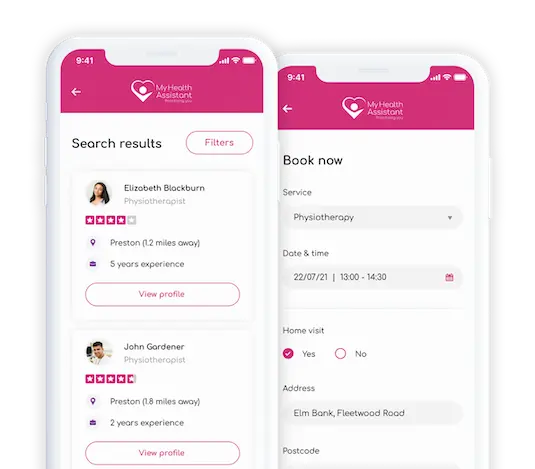My Health Assistant
Prioritising you
Not sure what you are looking for? Contact us
Not sure where to start?
Explore our guided search:

Not sure what you are looking for? Contact us



















































































































































































































































































My Health Assistant provides easy access to affordable healthcare services and treatment options, enabling you to take control of your health and decide on the best option for you.

With My Health Assistant, you can search for local healthcare services or book consultations and appointments online at any time.
Review a variety of profiles and choose somebody you will feel most at ease with, and who can best meet your needs.
Connect with local healthcare services and discuss the options for your treatment so you can decide what’s best for you.
It’s easy to tailor your search to match your exact needs, but if you are unsure on what service you require, you can contact one of the My Health Assistant team who are caring, approachable and supportive towards you and your needs. Our UK-based advisors are on hand to support you over the phone or online, so you never have to feel like you’re on your own.
Search for healthcare services and treatment options


















































































































































































































































































My Health Assistant is for anyone looking to book treatments directly with a private medical or health specialist in their local area. We don’t have any criteria and you don’t need to qualify your healthcare needs to use My Health Assistant. My Health Assistant enables you to take control of your health.
Sign up now
My partner identified a growing mark on his leg that despite three visits to his GP remained undiagnosed. After seeking help through a private medical practitioner, he received a swift diagnosis of early-stage skin cancer and was given the treatment he needed.

My mother began to lose her hair at 59 years old. It took many months to get appointments with her local GP and most treatments were not covered on the NHS. Frustrated at the slow progress she eventually decided to go private, getting immediate treatment of her choice and building her confidence back.

My four-year-old daughter struggles with clothes. She has hypersensitivity which affects her everyday life. We knew something wasn’t right but didn’t know who to speak to. After going private she was diagnosed with ADHD and sensory processing disorder. This enabled us to understand how to deal with her to support her and get the right professional support.

I felt stuck in a cycle of working in a job I didn’t enjoy just to pay my bills, and it was getting me down. I needed to make a change but didn’t know where to start. With the support of a life coach, I managed to build my confidence and focus on the type of opportunities I needed to further my career, doing something I love. Now, not only do I enjoy my work, the earnings and opportunities are endless. Having a focussed external view was exactly what I needed to support me in taking the steps I needed into a new career.
Download the My Health Assistant app to book appointments in just a couple of taps. You can manage yours and your family’s appointments on the go and make bookings no matter where you are. We put your healthcare in your hands, allowing you to take control of your health at the click of a button.


Musculoskeletal (MSK) physiotherapy is a specialised form of physical therapy aimed at treating conditions affecting the muscles, bones, joints, and soft tissues. If you’ve ever wondered, what is MSK physio?, it’s a comprehensive approach to managing pain, restoring mobility, and improving quality of life for individuals experiencing musculoskeletal disorders. Understanding MSK PhysiotherapyMSK physiotherapy targets problems caused by injuries, chronic conditions, or wear and tear on the body. These issues can range from back pain, arthritis, and joint sprains to sports injuries and post-surgical rehabilitation. A trained physiotherapist will assess your symptoms, identify the underlying causes, and create a personalised treatment plan that may include manual therapy, exercise programmes, education on posture, and advice for preventing future problems. What Can MSK Physiotherapy Help With?Common conditions treated by musculoskeletal physiotherapy include:Back and neck pain: Often resulting from poor posture, muscle strain, or disc issues.Joint problems: Such as arthritis, which can cause stiffness, swelling, and pain.Sports injuries: Including ligament sprains, muscle tears, and tendonitis.Post-operative rehabilitation: Helping patients recover mobility and strength after surgery.Work-related injuries: Addressing repetitive strain injuries and ergonomic issues. Who Should See an MSK Physiotherapist?People from all walks of life can benefit from MSK physiotherapy, whether they are athletes, office workers, or older adults dealing with age-related conditions. It’s not just for those with a diagnosed injury; if you experience persistent aches, limited mobility, or discomfort in daily activities, consulting an MSK physiotherapist could be the right step towards a more active and pain-free life. What to Expect from an MSK Physiotherapy SessionDuring an MSK physiotherapy session, the therapist will evaluate your range of motion, strength, and functional ability. Depending on the diagnosis, they may use techniques such as massage, joint mobilization, or even acupuncture to alleviate symptoms. Education is also a key aspect, helping patients understand their condition and the best ways to manage it. Why Choose MSK Physiotherapy?MSK physiotherapy not only focuses on relieving current symptoms but also on preventing future problems. By improving strength, flexibility, and posture, it helps reduce the risk of recurring issues. If you’re experiencing discomfort, it’s essential to seek help early to avoid worsening symptoms.My Health Assistant connects you with qualified MSK physiotherapists who can support you on your path to recovery. Don't wait - search local trusted professionals today.
Read more
What Are the Most Important Health Screenings for Men?Maintaining your health can feel overwhelming, especially when you're unsure which tests or screenings you need and when. To help you stay informed, we've created this guide on essential men's health screenings. By understanding what to prioritise, you can take control of your health and plan for a long, healthy future. Key Health Screenings by AgeIn Your 20s and 30sTesticular Cancer Screening: Although rare, testicular cancer is the most common cancer in young men. Regular self-examinations can help detect unusual lumps or swelling early on.Sexually Transmitted Infection (STI) Screening: If you're sexually active, regular STI screening is vital to maintaining your overall health and protecting your partners.Blood Pressure Check: Starting early is essential. Get your blood pressure checked at least every five years or more often if you have risk factors like a family history of heart disease or smoking. In Your 40sCholesterol Test: From your 40s onwards, it’s vital to monitor cholesterol levels regularly, particularly if you have a family history of heart disease or other risk factors.Diabetes Screening: Men over 40, especially those who are overweight or have a family history, should consider screening for type 2 diabetes. Early detection can help prevent complications later on.Prostate Cancer Screening: Discuss the pros and cons of screening with your doctor. Although the PSA test is widely used, it may not be necessary for every man in his 40s, depending on family history.In Your 50s and BeyondColorectal Cancer Screening: Starting at age 50, regular screenings for bowel cancer (via colonoscopy or home screening kits) become essential.Heart Health Check: Cardiovascular risk increases with age. A heart health check typically includes a blood pressure test, cholesterol test, and an evaluation of lifestyle risk factors.Prostate Health Check: Prostate issues, including cancer, become more common as you age. Talk to your doctor about regular prostate checks, especially if there’s a family history of prostate cancer. Diagnostic Tests and Wellbeing ChecksIn addition to routine health screenings, other diagnostic tests are essential for gaining deeper insights into your overall well-being. For instance, liver function tests are particularly valuable for individuals who consume alcohol regularly or take medications that may impact liver health. Men experiencing reduced libido or fatigue may benefit from hormonal testing, particularly testosterone levels, to determine if hormone imbalances are contributing to their symptoms, and male fertility testing may be useful for those planning on starting a family. Managing Medical ConditionsMen with a family history of certain conditions, or who are at higher risk, should consider more frequent testing:Heart Disease: If you have high blood pressure, high cholesterol, or a family history of heart disease, you may need more regular heart screenings.Cancer: If you have a family history of cancers like bowel, prostate, or testicular cancer, talk to your healthcare provider about early and frequent screenings.It’s crucial to consult your doctor for tailored advice on managing existing conditions and determining the best screening schedule for your needs. ConclusionTaking care of your health as a man doesn’t have to be overwhelming. By staying informed and scheduling regular men's health screenings, you can catch potential issues early and take proactive steps to maintain your well-being. From routine check-ups to more specific diagnostic tests, these screenings are essential tools for preventing illness and promoting long-term health. Whether you're focused on heart health, cancer prevention, or overall wellness, investing in your health now will pay off in the future. Book today and take control of your health!
Read more
When it comes to maintaining your health, it can be difficult to know exactly what screenings and tests you need, and when. With so much information out there, we know it can be confusing to navigate your health care needs. That’s why we've put together this handy guide on the most important health screenings for women at various stages of life. By understanding what to prioritise, you can take proactive steps toward a healthier future. Key Health Screenings by AgeIn Your 20s and 30sCervical Screening (Smear Test): Starting at age 25, women should have a cervical screening every three years to detect changes in cervical cells that could lead to cervical cancer. You still need to be screened even if you've had the HPV vaccine - whilst your risk of cancer is reduced if you've had the vaccine, it doesn't protect against all types of HPV.Sexually Transmitted Infection (STI) Screening: Regular STI screening is recommended for sexually active women to prevent and treat infections early.Breast Awareness: While routine mammograms aren’t usually necessary in your 20s and 30s, being aware of any changes in your breasts is important. You should also consider your risk factors, such as being overweight, smoking & drinking too much alcohol.In Your 40sBlood Pressure Check: High blood pressure can develop without symptoms, so it’s important to have your blood pressure checked at least every five years, or more frequently if you’re at risk.Cholesterol Test: Starting in your 40s, regular cholesterol tests are recommended, particularly if you have a family history of heart disease.Breast Screening (Mammogram): Women in the UK are invited for mammograms every three years from age 50, but if you're in your 40s and have risk factors like family history, you might consider earlier screening options.In Your 50s and BeyondBone Density Scan (DEXA): Osteoporosis becomes a concern as women age. A bone density scan can assess your risk of fractures and bone loss.Bowel Cancer Screening: Everyone aged 60 to 74 years who is registered with a GP and lives in England is automatically sent an NHS bowel cancer screening kit every 2 years. The programme is expanding so that everyone aged 50 to 59 years will be eligible for screening. It's a simple home test that checks for signs of bowel cancer. You may wish to opt for private screening if you are considered at risk, or want to be screened more regularly.Diabetes Screening: With age, the risk of type 2 diabetes increases. Regular screening can help catch it early, especially if you're overweight or have a family history. Diagnostic Tests and Wellbeing ChecksWhile routine screenings are key, there are other important diagnostic tests and checks to consider as you navigate different life stages. For women planning to start a family, fertility testing can provide insight into your reproductive health. Preconception health checks, including blood tests and genetic screening, help ensure you're in the best possible shape for a healthy pregnancy.Menopause brings its own set of challenges, and hormone testing can be valuable in managing symptoms. Monitoring levels of oestrogen and follicle-stimulating hormone (FSH) can give you a clearer picture of where you stand and help inform your decisions on lifestyle choices such as diet and exercise regimes.Don’t forget about your thyroid health, especially if you’re experiencing unexplained symptoms like fatigue or weight changes. Routine thyroid function tests can help detect any issues early on.Managing Medical ConditionsFor some women, a family history of certain conditions might necessitate more frequent or in-depth testing, earlier than the standard recommended screening age. Regular assessments and evaluation of risk factors can be vital to ensure that you're safeguarding your future health.Cancer: If you have a family history of cancers such as breast, ovarian, or bowel cancer, you may need earlier or more frequent screenings.Heart Disease: If you have risk factors such as high cholesterol, high blood pressure, or a family history of heart disease, consider more frequent cardiovascular screenings.Thyroid Screening: Women, especially those with a family history of thyroid issues or autoimmune diseases, should consider thyroid function tests. ConclusionTaking charge of your health doesn’t have to be overwhelming. By staying informed about the screenings and tests that are most relevant to your age and life stage, you can make proactive decisions that support your well-being. Whether it's routine screenings, diagnostic tests, or managing existing conditions, being aware and vigilant is key. Start with the basics, consult with your healthcare provider, and remember that these screenings are tools to help you live a healthier, fuller life. After all, your health is worth investing in.
Read moreYou can use My Health Assistant as an additional marketing tool for business generation, or even a complete virtual office, ensuring your time is focused on patients, not admin.
Find out more